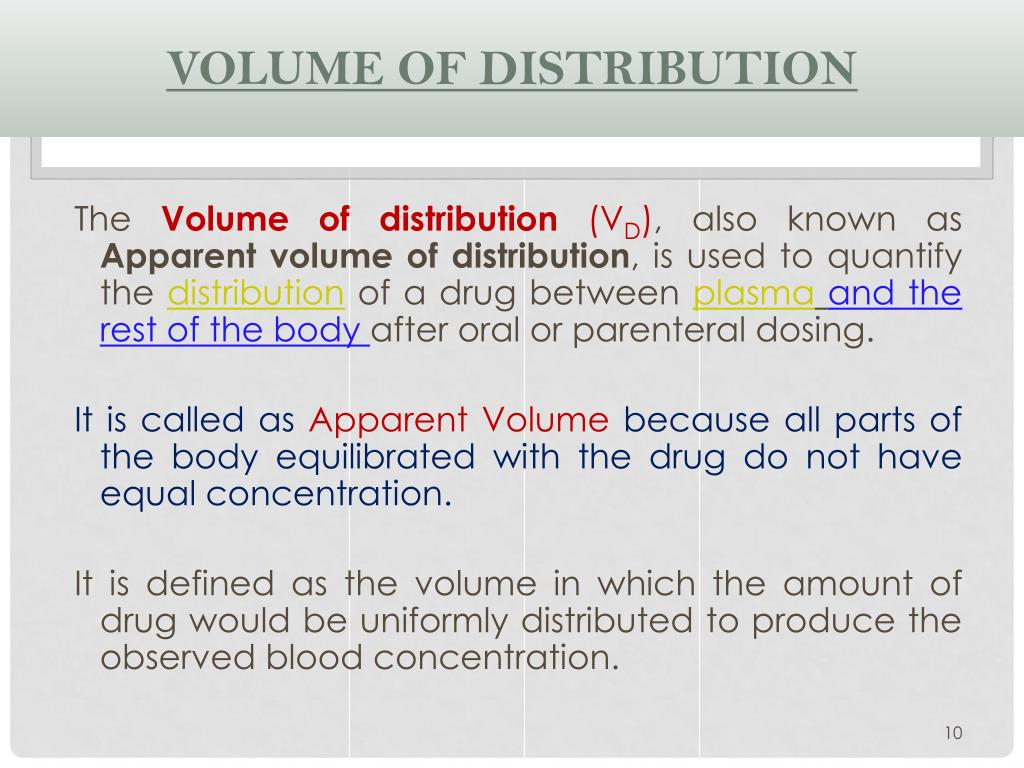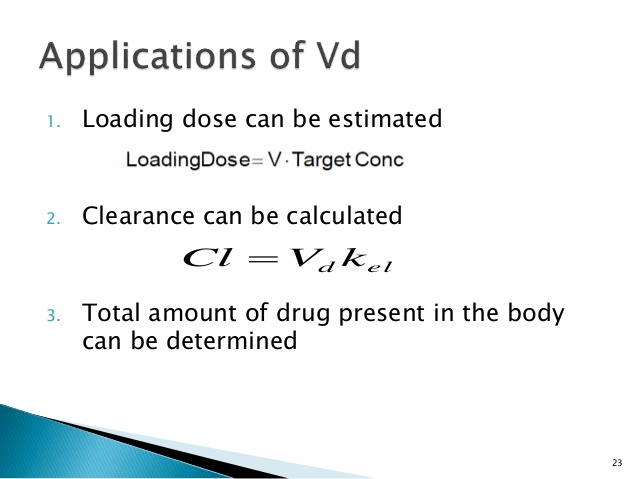

This type of model also has implications for effects of drugs on body tissues, i.e., therapeutic, toxic, or radiation exposure effects. In so doing, such a variable volume model could potentially provide unanticipated new information about time based tissue drug effects for tissue metabolism and/or eliminations. Such a model specifies when the drug volume reaches a particular size relative to its terminal apparent volume of distribution. This variable volume model implies an explicit relationship between redistribution and the rate of volume of drug distribution expansion in time. Niazi developed a temporally variable, apparent volume of distribution model for sum of exponential (SET) functions based on conservation of mass. Time varying apparent volume of distribution models based on exponential washout models for plasma concentration, have been developed previously.

For bolus experiments, in place of V SS we use the term V E for the expectation of a physical volume of distribution of drug, and unlike V SS, V E is invariant between constant infusion and bolus experiments. V SS for a constant infusion experiment is the terminal apparent volume of distribution, analogous to V area in a bolus model. The most commonly calculated volumes of distributions are the apparent volume of drug distribution immediately after bolus intravenous injection, i.e., at time zero, ( V 0), the terminal apparent volume of distribution following bolus intravenous administration ( V area) and the expected volume of distribution, called V E here, and often called Vss in the literature. In the following, we assume first order kinetics, i.e., that drug elimination is proportional to its concentration, which is the most common drug kinetic. While most drugs are actively redistributing from plasma into the body tissues, the decrease of plasma concentrations is largely due to that redistribution as opposed to actual drug elimination. During the dilution phase, hydrophilic drugs distribute into the body’s interstitial fluids with a time scale of hours or days. During the vascular phase, a drug mixes throughout the blood’s plasma volume with a time scale of seconds or minutes. This redistribution occurs in two distinct phases with very different time scales, a vascular phase and a washout or dilution phase. Following an intravenous bolus of drug, the volume of distribution of a drug varies with time. The apparent volume of distribution ( V d) is an important pharmacokinetic parameter that relates drug plasma concentrations to the amount of drug in the body and is important for drug loading dose and maintenance dose calculations. The funders had no role in study design, data collection and analysis, decision to publish, or preparation of the manuscript.Ĭompeting interests: The authors have declared that no competing interests exist. There was no additional external funding received for this study. J2012-114),, and the College of Medicine of the University of Saskatchewan. Russell at This work was supported by the Sylvia Fedoruk Canadian Centre for Nuclear Innovation (grant no.


This is an open access article distributed under the terms of the Creative Commons Attribution License, which permits unrestricted use, distribution, and reproduction in any medium, provided the original author and source are credited.ĭata Availability: The third party data is available from Dr. Received: FebruAccepted: JPublished: July 12, 2016Ĭopyright: © 2016 Wesolowski et al. PLoS ONE 11(7):Įditor: Damir Janigro, Cleveland Clinic, UNITED STATES Citation: Wesolowski CA, Wesolowski MJ, Babyn PS, Wanasundara SN (2016) Time Varying Apparent Volume of Distribution and Drug Half-Lives Following Intravenous Bolus Injections.


 0 kommentar(er)
0 kommentar(er)
